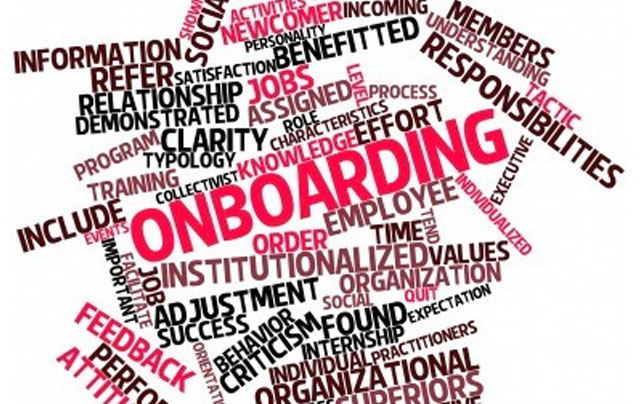
It’s a new year and many companies are looking at open positions, talent management and succession planning. One area that we see clients struggle with is having a comprehensive onboarding approach. Typically, companies invest heavily in their process upfront to attract and recruit talent but when it comes to having a dedicated and comprehensive effort to onboard these employees to their new roles there is often a lack of attention.
What do most employees want?

When we have surveyed professionals about what they want in their onboarding the following responses are most frequent:
- To be given clear expectations
- Understand how they will be measured
- To feel connected to a culture/ be valued
- Make an Impact: their contribution ties to the mission and vision
- Feedback that goes two ways
- How to build an internal network
- Learning and development opportunities
- Coaching and Mentorship
Accelerating the Investment
While companies often make a significant investment of time and resources in attracting and recruiting talent, once an offer is accepted the momentum declines, and the new or newly promoted employee is just expected to get started. Although most companies say onboarding is important, research states that more than 30% of global leaders said that they received little or no onboarding. This lack of onboarding can have a negative impact to performance and profitability, besides creating job dissatisfaction and resentment. Then there is the impact to the morale and focus of a team and organization. Turnover is costly, especially when the attrition happens quickly. If there is little or no onboarding the likelihood of failure to perform and attrition rises dramatically.
Onboarding is Not New Employee Training
Filling out admin forms and having a buddy take you to lunch does not constitute onboarding. Even companies that do significant training on their products and services and send employees to their training academy for the first month are not off the hook with onboarding. True onboarding is the next step of an organizational socialization process that a manager needs to own with their employee and conduct over the first 3-6 months to help guide the individual to be successful, navigate the organization, understand the culture, and make a constructive contribution. Onboarding accelerates the learning that employees get from training and puts it into action.
Making the investment up-front yields higher productivity more quickly, with less trouble-shooting of problems and potential performance issues later. We believe it’s imperative that you prepare the new employee/leader to understand the professional and cultural aspects of their role. It’s important to help guide them to know who should be on their stakeholder map, how decisions are made and what the organization’s risk tolerance is and what actions they should take to drive results. The Boston Consulting Group found that organizations with strong onboarding programs see the financial impact and experience 1.9 times the profit margins and 2.5 times the profit growth. This type of impact doesn’t happen from ticking the box in new-employee orientation.
We know the risks of not onboarding employees effectively is that people don’t do well in their roles and they may leave. Besides the attrition cost there can be a negative impact to your company brand. Social media spreads like wildfire and companies without onboarding may get labeled #setup4failure.
So, if we know it’s something we should do and it has positive benefits and impacts profits, why don’t we do it? Well these are some of the misconceptions/excuses we hear why companies don’t commit to a robust onboarding process.
1. We don’t have the time!
Especially when positions have been vacant and/or there is a market pressure companies will say we need people to perform and we don’t have the luxury of time to do a lot of onboarding. We would argue that most robust onboarding is crucial to get employees up and running and contributing effectively. Our experience is that to do onboarding well you need about 6-10 hours of concentrated time and effort between a manager and employee in their first 3-6 months in the company. We view that the time may increase when we move into the C suite, the job has more complexities, like taking on global responsibility and there are more stakeholders. Truly the biggest risk is not doing it and having low performance or a new hire or newly promoted employee leave the company. For these reasons and the cost to the organization, we reason that companies don’t have the option to not take the time. some time.
2. Is it truly necessary? There’s no guarantee it will make a difference:
Too many times companies are impatient to get a new employees started. We often hear from clients that have not spent the time onboarding things like, “Shouldn’t they understand our culture, they met with 5 people” “They are from the industry– they should get it.” While onboarding is not a magic bullet to make sure every person works out perfectly it can safeguard against statistics like up to 20% of staff turnover happens in the first 45 days and lean more towards the 77% of employees that have robust onboarding reach their goals. Onboarding cements a platform that has begun during the recruiting process and it provides them the map with how to be successful in the organization. Onboarding is not just for new employees but for internal ones as well, transitioning to new roles.
3. We give people autonomy and they need to figure it out:
It’s not about micro managing but it seems risky to provide employees with a “sink or swim” mentality when joining an organization or taking on new responsibilities. This approach has about a 50% success rate and beside the cost of attrition there is a ripple effect on morale and culture and this can negatively impact the willingness for people to take on new challenges. Especially with succession planning, internal onboarding must be done to provide a clear development path for people to be successful.

Best Practice Approach for Onboarding
A comprehensive onboarding approach has structure, consistency and is done effectively over the first 3-6 months of a new role. This is not a one-time conversation that the manager has on the first day. Rather it is creating a platform of understanding that continues to be built upon, discussed, refined and measured. In our opinion, onboarding is executed in a structured and comprehensive approach that can even start before the employee starts and has various check points and feedback opportunities that should be spread over at least the first 3-6 months. There is a ripple effect when done right and it cascades across the organization and becomes part of the culture. When done consistently it makes it easier to spot problems and take corrective action and keep the level of performance and engagement high. We hope organizations commit to doing this and we encourage our individual coaching clients taking new roles to onboard and advocate themselves.
If your organization is interested in learning more and getting support with your onboarding efforts, please contact Michèle Barnett Berg – michele.berg@mcgpartners.com
About the Author: Michèle Barnett Berg
About MCG Partners
MCG Partners a woman-owned, Greater Boston-based consultancy specializing in executive coaching, leadership development, talent management, and organizational development solutions. We help businesses optimize success through the entire management life-cycle. MCG Partners is also a Predictive Index® (PI®) certified partner.
To learn more about MCG Partners’ services or The Predictive Index®, contact John Griffith at john.griffith@mcgpartners.com or visit mcgpartners.com.
[/fusion_text][/fusion_builder_column][/fusion_builder_row][/fusion_builder_container]







